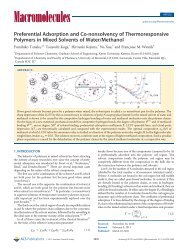pdf file
pdf file
pdf file
You also want an ePaper? Increase the reach of your titles
YUMPU automatically turns print PDFs into web optimized ePapers that Google loves.
6 T. MATSUKIProposition 2. Let a and b be elements of T + . Then b = lah −1 for some l ∈H ′ and h ∈ H ⇐⇒ b = waw −1 for some w ∈ N K∩H (t). Here N K∩H (t) is the normalizerof t in K ∩ H. (Write K = G θ as usual.)Proof. Since the implication ⇐= is clear, we have only to prove =⇒. Supposeb = lah −1 for some l ∈ H ′ and h ∈ H. Put t ′ = Ad(l)t = Ad(la)t = Ad(bh)t. Thent ′ is a maximal abelian subspace of q ′ ∩ Ad(b)q. Since (h ′ ∩ Ad(b)h, q ′ ∩ Ad(b)q)is a compact symmetric pair by Lemma 2, there is an x ∈ H ′ ∩ bHb −1 such thatAd(x)t ′ = t. Put l ′ = xl ∈ H ′ and h ′ = b −1 xbh ∈ H. Then we haveand(2.6)l ′ ah ′ −1 = xlah −1 b −1 x −1 b = xbhh −1 b −1 x −1 b = bl ′ T h ′ −1 = xlT h −1 b −1 x −1 b = xlaT h −1 b −1 x −1 b= xbhT h −1 b −1 x −1 b = xT ′ x −1 b = T b = Twhere T = exp t and T ′ = exp t ′ .Since l ′ h ′ −1 = l ′ eh ′ −1 ∈ T by (2.6) and since l ′ T l ′ −1 l ′ h ′ −1 = T also by (2.6), wehave l ′ T l ′ −1 = T. Write l ′ = k exp X with k ∈ K ∩ H and X ∈ m ∩ q. Then it iswell-known that [X, t] = {0} by a standard argument. (Suppose Ad(k exp X)Y = Y ′for some Y, Y ′ ∈ k. Then applying θ, we have Ad(k exp(−X))Y = Y ′ and thereforeAd(exp 2X)Y = Y . Since adX : g → g is expressed by a real symmetric matrix, wehave [X, Y ] = 0.)Hence we have kT k −1 = T and b = l ′ al ′ −1 l ′ h ′ −1 = kak −1 l ′ h ′ −1 . We have only toprove c = l ′ h ′ −1 = e. Write h ′ = k ′ exp X ′ with k ′ ∈ K ∩ H and X ′ ∈ m ∩ h. Then itfollows from l ′ = ch ′ that k exp X = ck ′ exp X ′ . Since c ∈ T ⊂ K, we have k = ck ′and X = X ′ = 0. Hence c ∈ T ∩ H. Since kak −1 , b ∈ exp t + , we have c = e byLemma 1 (iv).q.e.d.3. Construction of a function ρWrite W = N K∩H (t)/Z K∩H (t). Let ρ 0 be a W -invariant real analytic function ont + which has no critical points except the origin. For the sake of later use, we shouldalso assume ρ 0 (Z) tends to +∞ when Z goes to the boundary of t + . For example,we may putρ 0 (Z) =∑ 1(3.1)π − 2iα(Z).α∈Σ(m C ,t)This function (3.1) is clearly convex and therefore it has no critical points exceptthe origin. By Proposition 2 and Lemma 1 (iv), we can define a function ρ on D byρ(l(exp Z)h) = ρ 0 (Z) for l ∈ H ′ , h ∈ H and Z ∈ t + .Proposition 3. ρ is real analytic on D.Proof. By the left H ′ -action and the right H-action on D, we have only to showρ is real analytic at every a = exp Y ∈ T + . Consider the right a-translateρ a (x) = ρ(xa)for x ∈ Da −1












